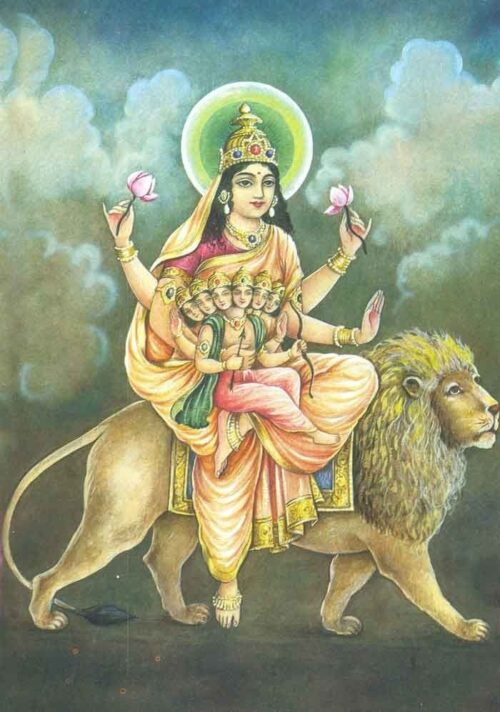
Devi Skandamata fifth day of Navratri
Skandamata, the fifth manifestation of Goddess Durga, is celebrated with great reverence and devotion during the auspicious festival of Navaratri. As a symbol of motherhood and nurturing love, Skandamata is worshipped on the fifth day of Navaratri. Her name is derived from two words: “Skanda,” which refers to Lord Kartikeya (also known as Skanda), and “Mata,” meaning mother. Skandamata is depicted holding her son, Lord Skanda, in her lap, symbolizing the bond between a mother and her child.
Iconography:
Skandamata is portrayed with four arms, holding lotus flowers in her upper two hands while cradling baby Skanda in her lower right arm. Her lower left arm is in a posture of blessing her devotees. She rides a lion, representing strength and fearlessness. Skandamata’s complexion is often depicted as radiant, signifying her divine presence and grace.
Symbolism and Significance:
Skandamata is the epitome of maternal love, care, and protection. Her portrayal with Lord Skanda emphasizes the importance of a mother’s role in nurturing her children and guiding them on the right path. The lion she rides signifies courage, valor, and power, reflecting her ability to protect her devotees from all adversities.
According to Hindu scriptures, after the demons were defeated by the gods, their leader, Tarakasura, had a boon that he could only be killed by a son of Lord Shiva. In response, Lord Shiva agreed to marry Parvati and their son, Lord Kartikeya, was born. Skandamata is the loving mother who nurtured Lord Kartikeya and instilled in him the qualities of valor and righteousness, making him the commander of the divine forces
Worship and Devotion of Skandmata
Devotees worship Skandamata on the fifth day of Navaratri to seek her blessings for the well-being and protection of their children. It is believed that her benevolent gaze protects her devotees from harm and evil influences. People offer fruits, flowers, and other auspicious items to please the goddess. Chanting the mantra “Om Devi Skandamatayai Namah” is a way to invoke her divine presence and seek her maternal blessings.
Relevance in Modern Times:
The worship of Skandamata holds deep significance in modern society. In a world filled with challenges and uncertainties, her portrayal as a caring and protective mother serves as an inspiration for nurturing relationships and fostering love and compassion. Skandamata’s divine presence reminds individuals of the importance of familial bonds, maternal love, and the strength that lies within the nurturing aspect of life.
In conclusion, Skandamata stands as a beacon of love, protection, and maternal care. Her worship not only strengthens the bond between parents and children but also instills a sense of security and courage in the hearts of her devotees. Through her divine grace, individuals are reminded of the power of love, the significance of protection, and the unwavering support that a mother provides to her children, both in mythological tales and in the realities of everyday life.
Read about maa kushmanda, the fourth day of navaratri https://orangedosa.com/hinduism/maa-kushmanda-on-the-fourth-day-of-navaratri/
One thought on “Devi Skandamata fifth day of Navratri”